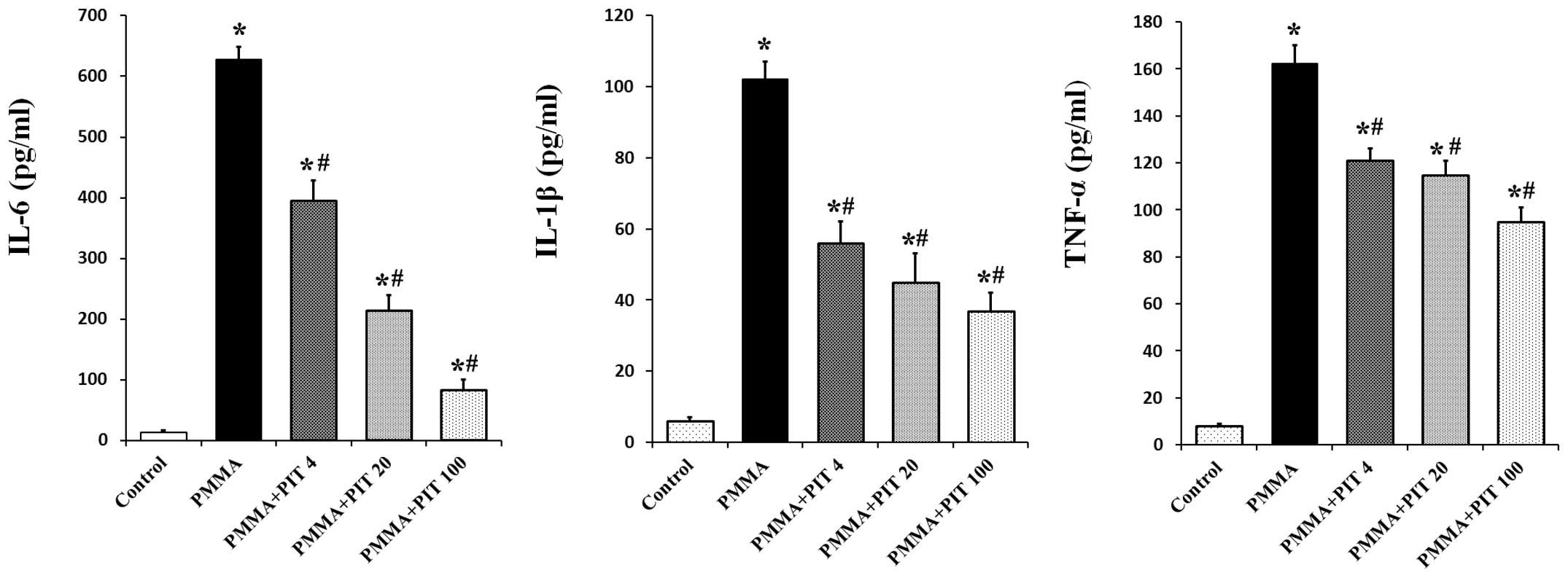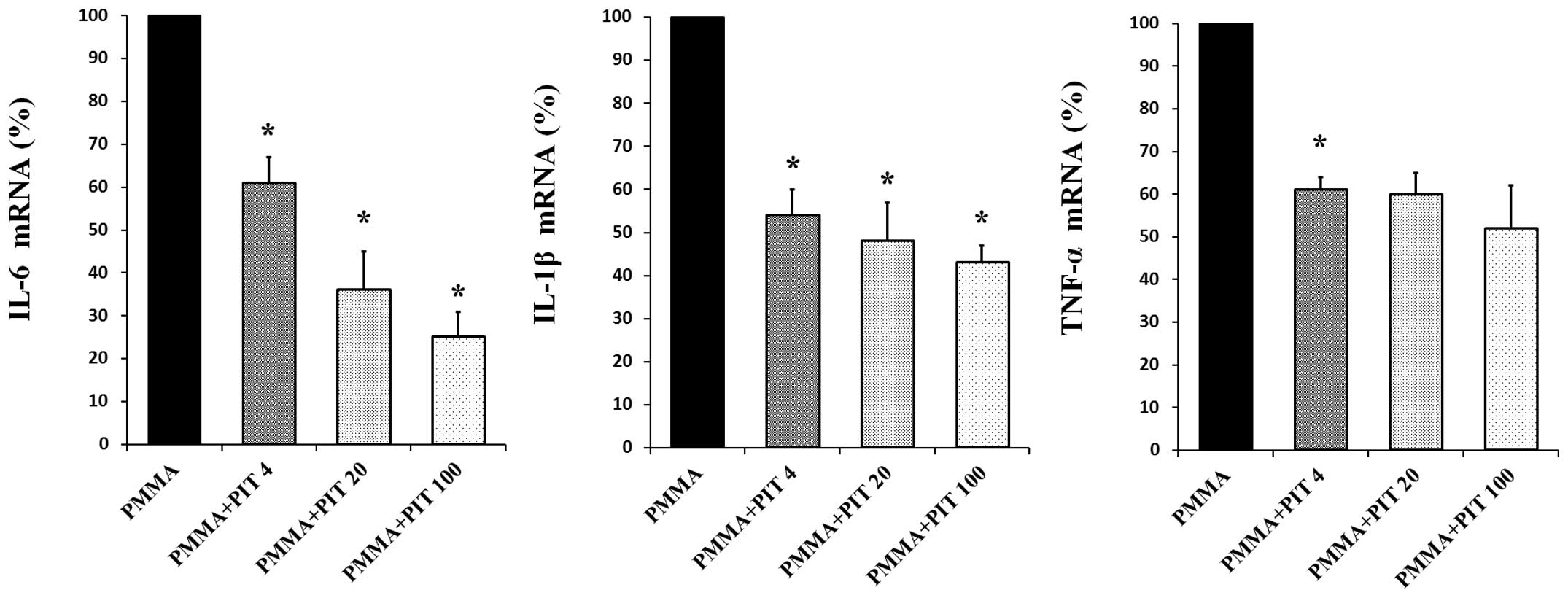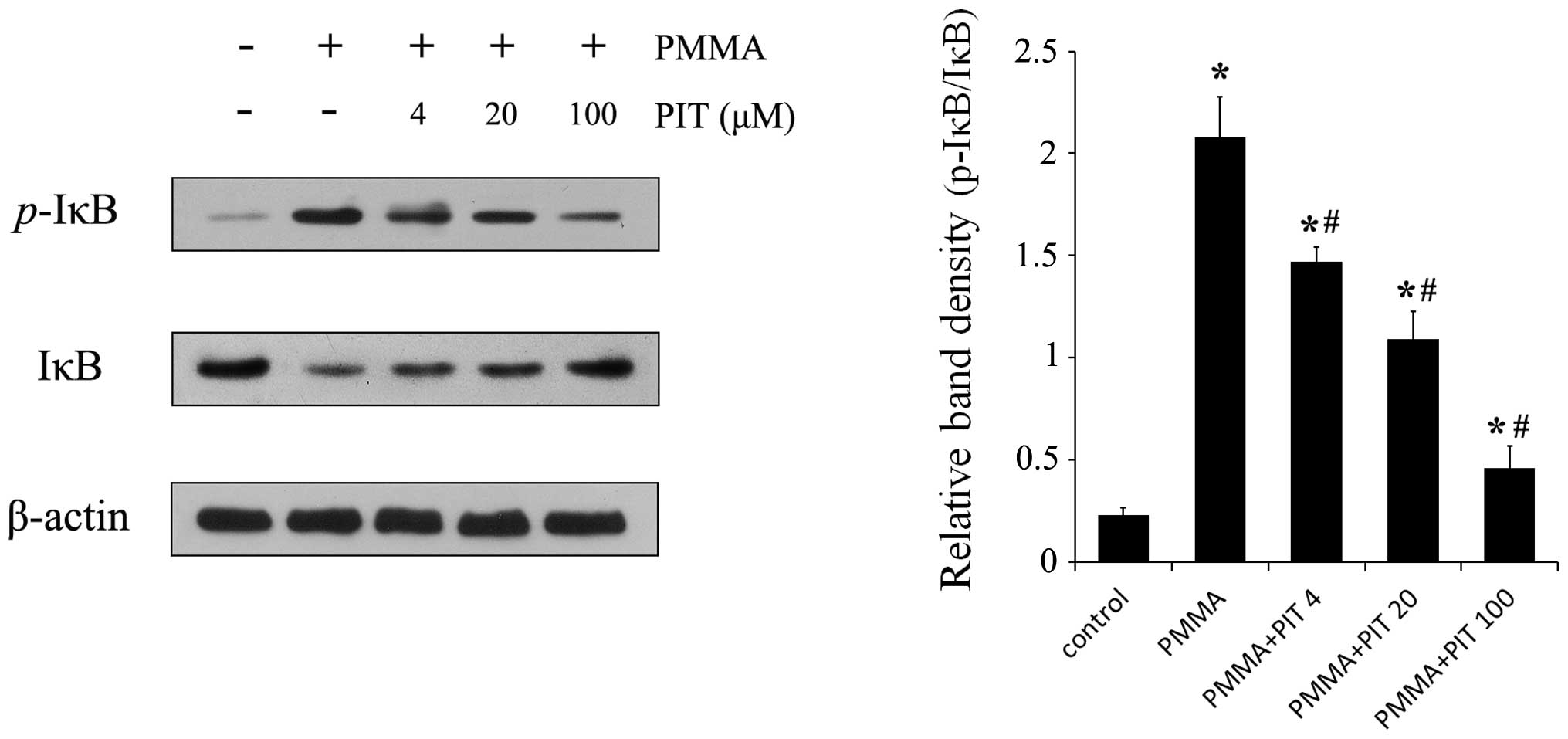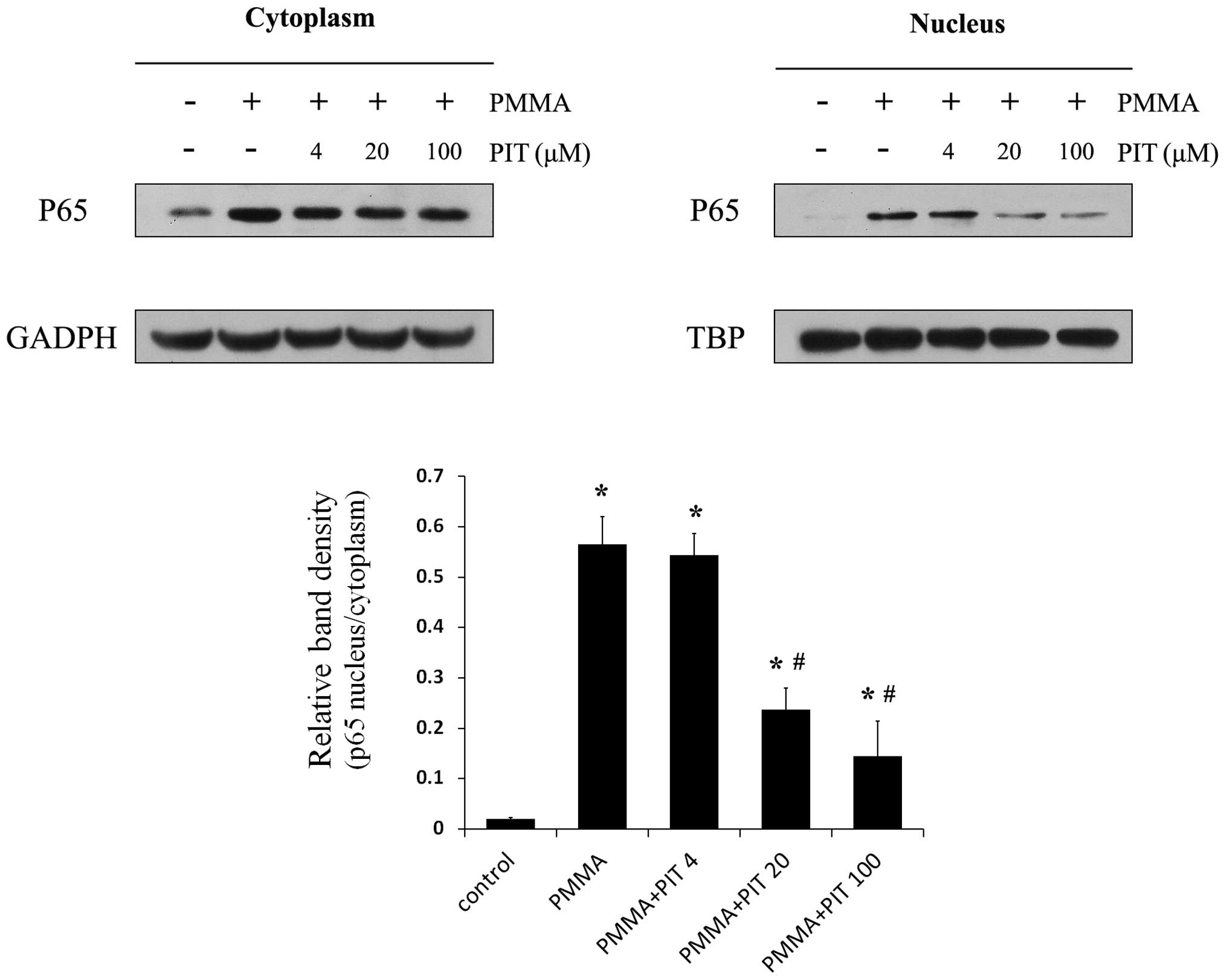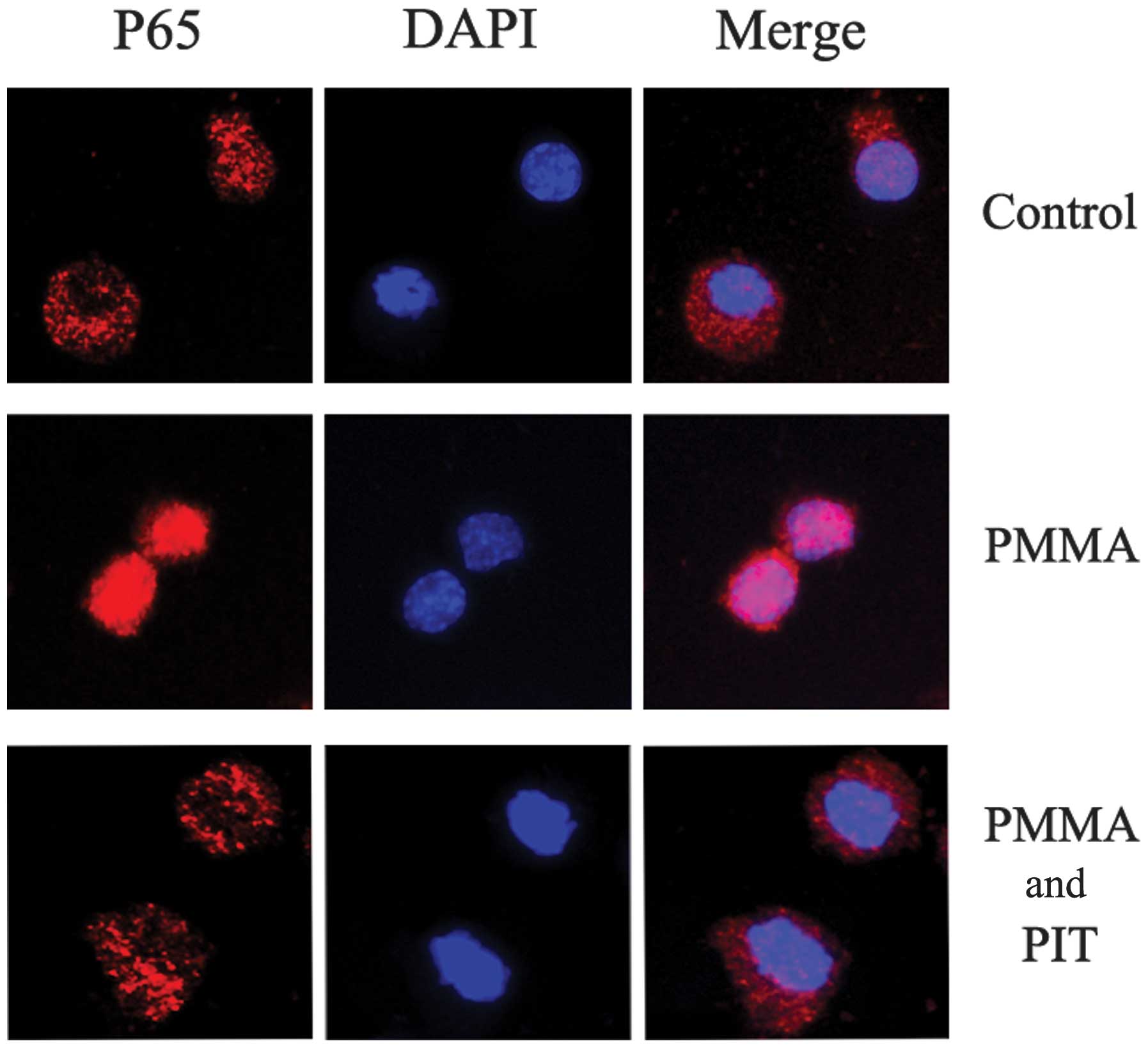Pitavastatin attenuates monocyte activation in response to orthopedic implant‑derived wear particles by suppressing the NF‑κB signaling pathway
- Authors:
- Published online on: September 9, 2015 https://doi.org/10.3892/mmr.2015.4306
- Pages: 6932-6938
Abstract
Introduction
Total joint replacement (TJR), by the implantation of permanent prosthetic components, is currently considered to be a particularly successful clinical procedure in orthopedic surgery (1). However, wear particle-induced periprosthetic osteolysis and subsequent aseptic loosening continue to be major causes of arthroplasty failure (2). Implant-derived wear particles activate and recruit macrophages and osteoclasts around and at the implant-host interface (3). These cells secrete high levels of inflammatory cytokines, such as interleukin (IL)-1β, IL-6, and tumor necrosis factor (TNF)-α that mediate and accelerate the inflammatory and osteolytic responses, which result in the loosening and subsequent failure of bone implants (4). Thus, the application of pharmacological agents for the prevention of this osteolytic response to wear debris has attracted significant interest, with particular emphasis on anti-inflammatory agents.
Pitavastatin, a 3-hydroxy-3-methylglutaryl coenzyme A (HMG CoA) reductase inhibitor, effectively modifies atherogenic lipid profiles and thereby reduces cardiovascular risk in individuals presenting with dyslipidemia and cardiometabolic diseases (5). Unlike other statins, the characteristic structure of pitavastatin provides improved pharmacokinetics and significant low-density lipoprotein cholesterol-lowering efficacy at low doses (6). In addition, increasing evidence indicates that pitavastatin exhibits numerous pleiotropic effects beyond its lipid-lowering potencies. In a previous study, pitavastatin at a low dose (1 µM) inhibited nuclear factor κ-light-chain-enhancer of activated B cells (NF-κB) activation and decreased IL-6 production, which was induced by TNF-α in human breast cancer cells (7). Takano et al (8) demonstrated that pitavastatin prevented acute lung injury development in septic mice by increasing glucocorticoid receptor expression and downregulating NF-κB activation in alveolar macrophages. Katsuki et al (9) showed that pitavastatin treatment inhibited atherosclerotic plaque destabilization and rupture in a mouse model of diet-induced lipodystrophy by regulating monocyte chemoattractant protein-1/C-C chemokine receptor type 2-dependent monocyte recruitment. Furthermore, various clinical studies identified that pitavastatin therapy significantly decreased in-hospital or 28-day mortality in patients exhibiting infection and sepsis (10). However, pitavastatin has not been considered as an effective tool with therapeutic potential in the prevention of osteolysis in response to orthopedic wear particles.
The present study investigated whether treatment with pitavastatin (a new synthetic statin drug) was able to alleviate the activation of the monocyte inflammatory response induced by polymethyl methacrylate (PMMA) particles. The production of pro-inflammatory cytokines and the intracellular NF-κB signaling pathway were also examined to identify the role of pitavastatin in monocyte activation..
Materials and methods
Preparation of PMMA particles and pitavastatin
Spherical PMMA particles (Polysciences, Inc., Warrington, PA, USA) 1–10 µm in diameter (mean diameter, 6.0 µm; 95% <10 µm) were used for all experiments as previously reported (11–13). The particles were rinsed four times in 70% ethanol, sterilized in 70% ethanol (Sigma-Aldrich, St. Louis, MO, USA) overnight, then washed four times in sterile phosphate-buffered saline (PBS; Wuhan Boster Biological Technology, Ltd., Wuhan, Hubei, China). Particles were resuspended in serum-free Minimum Essential Medium (MEM; Life Technologies, Grand Island, NY, USA) and stored at −20°C. A Limulus Amebocyte Lysate kit (BioWhittaker, Walkersville, MD, USA) was used to detect bacterial endotoxins. The optimal PMMA particle concentration for cell culture experiments was identified to be 2 mg/ml. The pitavastatin (Sigma-Aldrich) was stored at −20°C until it was diluted in serum-free MEM immediately prior to use.
Monocyte isolation
Peripheral whole blood was obtained from healthy volunteers (n=12) into heparinized bottles (Shandong Weigao Group Medical Polymer Co., Ltd., Weihai, China). The twelve subjects recruited for the study were healthy male volunteers aged between 23–45 years. All volunteers enrolled in the present study provided written informed consent. Blood collection was conducted between January and June 2014 at the Southwest Hospital of the Third Military Medical University (Chongqing, China). The heparinized blood was diluted in equal volumes of 10 ml Dulbecco's modified Eagle's medium (Gibco Life Technologies, Carlsbad, CA, USA) supplemented with 10% fetal bovine serum (Gibco Life Technologies) and maintained at 37°C. The 20 ml of diluted blood samples were then layered onto 10 ml of Ficoll-Paque PLUS (GE Healthcare Bio-Sciences, Uppsala, Sweden) and centrifuged at 500 × g for 30 min. The buffer mononuclear layer was removed and washed three times with PBS, and then plated in 12-well plates (Corning Incorporated, Corning, NY, USA) in 5×105/ml Dulbecco's modified Eagle's medium supplemented with 10% fetal bovine serum. All steps were carried out at room temperature. The monocyte population was allowed to adhere for 120 min at 37°C in an atmosphere of 5% CO2. Cells (lymphocytes) that had not adhered were subsequently washed off using PBS and the remaining monocyte population was used.
Measurement of cytokines
Monocytes were treated with various concentrations of PIT (0–100 µM) together with 2 mg/ml PMMA for 12 h. The culture medium was subsequently collected and the concentrations of TNF-α, IL-1β and IL-6 were measured using a commercially available ELISA kit (Wuhan Boster Biological Technology, Ltd.) according to the manufacturer's instructions. The absorbance was measured at 450 nm using a microplate reader (Bio-Tek ELX800; Bio-Tek Instruments, Inc., Winooski, VT, USA).
Reverse transcription-quantitative polymerase chain reaction (RT-qPCR) assay
Total cellular RNA was isolated using TRIzol (Invitrogen Life Technologies, Camarillo, CA, USA) and cDNA was synthesized using SuperScript® Reverse Transcriptase (Invitrogen Life Technologies) according to the manufacturer's instructions. The primer sequences (Shanghai Shenggong Co., Ltd., Shanghai, China) used in the present study were as follows: Forward, 5′-CGAGTCTGGGCAGGTCTA-3′ and reverse, 5′-CGAAGTGGTGGTCTTGTTG-3′ for TNF-α; forward, 5′-CTTCAGGCAGGCAGTATCACTC-3′ and reverse, 5′-TGCAGTTGTCTAATGGGAACGT-3′ for IL-1β; forward, 5′-TCAATGAGGAGACTTGCCTG-3′ and reverse, 5′-GATGAGTTGTCATGTCCTGC-3′ for IL-6; and forward, 5′-TCACCACCATGGAGAAGGC-3′ and reverse, 5′-GCTAAGCAGTTGGTGGTGCA-3′ for GAPDH. RT-qPCR was performed using a LightCyclerH 480 Instrument (Roche Diagnostics GmbH, Mannheim, Germany) and SYBR® Green SuperMix (Sigma-Aldrich). The amplification program included an initial denaturation step at 95°C for 5 min and 45 cycles (each consisting of denaturation at 95°C for 10 sec), annealing at 60°C for 10 sec and extension at 72°C for 10 sec. The comparative cycle threshold (Ct) method (2−ΔΔCT) was used to calculate relative gene expression. The results were expressed as the fold change over the control values.
Western blotting
Cells were collected and lysed in radioimmunoprecipitation assay buffer (Sigma-Aldrich) supplemented with a Broad Spectrum Protease Inhibitor Cocktail (BD Pharmingen, San Diego, CA, USA). Following centrifugation for 10 min at 10,000 × g, the protein content of the supernatant was determined using a bicinchoninic acid assay kit (Beyotime Institute of Biotechnology, Shanghai, China). The protein lysates were separated by 10% SDS-PAGE (Beyotime Institute of Biotechnology) and subsequently electrotransferred onto a polyvinylidene difluoride membrane (EMD Millipore, Billerica, MA, USA). The membrane was blocked with 5% bovine serum albumin (Sigma-Aldrich) for 1 h at room temperature. The blocked membranes were incubated overnight at 4°C with the following primary antibodies: Rabbit anti-NF-κB monoclonal antibody (1:600; cat. no. sc-372), rabbit anti-p-inhibitor of κB (IκB) monoclonal antibody (1:600; cat. no. sc-101713), rabbit anti-IκB monoclonal antibody (1:600; cat. no. sc-371), rabbit anti-GADPH monoclonal antibody (1:1,000; cat. no. sc-25778) and rabbit anti-TATA box binding protein monoclonal antibody (1:1,000; cat. no. sc-33736), which were all purchased from Santa Cruz Biotechnology, Inc. (Dallas, TX, USA). The membranes were then incubated with horseradish peroxidase-linked goat anti-rabbit immunoglobulin G (1:10,000; Cell Signaling Technology, Inc., Danvers, MA, USA) for 1 h at room temperature. Protein bands were visualized using a western blotting detection system (ChemiDoc™ XRS+; Bio-Rad Laboratories, Hercules, CA, USA) and analyzed by a densitometry system (Quantity One v4.6.2; Bio-Rad Laboratories) according to the manufacturer's instructions.
For extraction of the nucleoprotein, cells were collected and lysed in the lysis buffer [10 mM Hepes (pH 7.9), 1.5 Mm MgCl2, 10 mM KCl, 0.5 mM dithiothreitol, 2% NP-40, 1 mM phenylmethylsulfonyl fluoride] (Beyotime Institute of Biotechnology) for 20 min, and the lysis buffer was centrifuged at 1,000 × g for 10 min. The protein content of the supernatant was collected as the cytoplasmic protein. The precipitate was washed twice and lysed in lysis buffer containing Triton X-100 (Sigma-Aldrich) and collected as the nucleoprotein.
Immunofluorescence
Monocytes were seeded onto 12-well plates, grown in chamber slides and treated with 2 mg/ml PMMA and/or 100 mM pitavastatin for 1 h. Cells were fixed with 4% paraformaldehyde (Nanjing Jiancheng Bioengineering Institute, Nanjing, China) and permeabilized with 0.5% Triton X-100. Immunostaining of p65 was performed using rabbit anti-p65 monoclonal antibody (cat. no. sc-372; Santa Cruz Biotechnology, Inc.) at a dilution of 1:200, then with fluorescein isothiocyanate-conjugated goat anti-rabbit immunoglobulin G secondary antibody (Abcam, Cambridge, MA, USA) at a dilution of 1:5,000. Finally, the cells were stained with DAPI (Beyotime Institute of Biotechnology) for 10 min to localize the nuclei, which served as a reference point. For the negative controls, the primary antibodies were excluded from the staining procedure described above. The activation of NF-κB was defined by its translocation into the nucleus, which was visualized by fluorescence microscopy (magnification, ×20) using a Nikon Eclipse E1000 (Nikon Corporation, Tokyo, Japan).
Statistical analysis
All results are expressed as the mean ± standard deviation. The results were analyzed by analysis of variance, followed by Student's t-test to determine the significance. P<0.05 was considered to indicate a statistically significant difference. All the statistical analyses were performed using the SPSS 12.0 statistical software (SPSS, Inc., Chicago, IL, USA).
Results
Pitavastatin inhibits PMMA-induced pro-inflammatory cytokine production
PMMA particles are widely derived from implants used in TJR, as they result from wear of the material in the prosthetic. Thus, in the present study, PMMA particles served as a stimulant to trigger inflammatory monocytes. Varying concentrations of PMMA (1, 2 and 4 mg/ml) were added into the monocyte culture medium 6, 12 or 24 h prior to analysis. It was found that in all of the PMMA concentration groups, the pro-inflammatory cytokines were increased in a time-dependent manner and there was no significant differences noted between the 2 and 4 mg/ml PMMA groups (data not shown). Therefore, a PMMA particle concentration of 2 mg/ml was selected and administered 24 h prior to the cell culture experiments.
To study the effect of pitavastatin, 2 mg/ml PMMA was applied to stimulate the monocytes, and 0–100 µM pitavastatin was simultaneously administrated. After 24 h, as seen in Fig. 1, 2 mg/ml PMMA induced a significant production of TNF-α, IL-1β and IL-6 in the monocytes (P<0.05). However, pitavastatin treatment significantly inhibited the production of pro-inflammatory cytokines in a dose-dependent manner (P<0.05).
Pitavastatin inhibits PMMA-induced TNF-α, IL-1β and IL-6 mRNA expression
RT-qPCR was conducted to assess whether pitavastatin inhibits TNF-α, IL-1β and IL-6 mRNA expression. As demonstrated in Fig. 2, PMMA stimulation of monocytes resulted in a marked increase in TNF-α, IL-1β and IL-6 at the transcriptional level. However, treatment with varying concentrations of pitavastatin (4, 20 and 100 µM) significantly downregulated PMMA-induced transcription of TNF-α, IL-1β and IL-6 mRNA in a concentration-dependent manner (P<0.05).
Pitavastatin inhibits PMMA-induced IκB phosphorylation and degradation
NF-κB is considered to be a master switch in the regulation of inflammation and immunity (14). As a transcription factor, NF-κB controls an array of pro-inflammatory genes involved in the inflammatory signaling cascade, such as TNF-α, IL-1β, and IL-6 (15). Therefore, the effect of pitavastatin on PMMA-induced NF-κB activation in monocytes were investigated. As shown in Fig. 3, monocytes treated with PMMA exhibited significant phosphorylation of IκB, whereas the various treatment concentrations of pitavastatin (4, 20 and 100 µM) prevented IκB phosphorylation. In addition, pitavastatin inhibited degradation of IκB, which had been induced by PMMA, in a concentration-dependent manner. These results indicate that pitavastatin significantly blocks the NF-κB signaling pathway in PMMA-stimulated monocytes by suppressing IκB phosphorylation and degradation.
Pitavastatin inhibits PMMA-induced NF-κB p65 translocation
Having established that pitavastatin inhibits IκB phosphorylation and degradation, further investigations regarding its effects on NF-κB signaling were performed. The p65 protein levels in the cytoplasmic and nuclear fractions of PMMA-induced monocytes were analyzed. As shown in Fig. 4, PMMA stimulation resulted in significant nuclear translocation of p65 in the monocytes, whereas pitavastatin treatment prevented the accumulation of PMMA-induced nuclear p65 in a concentration-dependent manner. Furthermore, immunocytochemical analysis demonstrated that pitavastatin treatment exhibited reduced nuclear translocation of endogenous p65 following PMMA stimulation (Fig. 5). These results indicate that pitavastatin significantly inhibits NF-κB p65 translocation in PMMA-stimulated monocytes.
Discussion
TJR is considered to be the most effective treatment strategy for end-stage joint diseases, such as osteoarthritis and rheumatoid arthritis (16). However, despite the clinical effectiveness of TJR, aseptic loosening of prostheses continues to present a major problem, particularly for the long-term success and survival of a prosthesis (17). There are various causes of aseptic loosening, however, an inflammatory reaction induced by excessive production of wear particles from the implant components and consequent peri-implant osteolysis is regarded as the primary cause (18).
PMMA particles, a material widely derived from orthopedic implants, elicit a marked inflammatory response due to macrophage and enhanced osteoclast formation and activity (19–21). Upon exposure to PMMA, osteoblasts contribute to periprosthetic osteolysis by secreting mediators that drive the inflammatory process (22). These mediators, which include TNF-α, IL-1β and IL-6, interact with one another contributing significantly to the inflammatory cascade. TNF-α is considered to be a key cytokine, which mediates particle-driven osteoclastogenesis and osteolysis (23). TNF-α increases osteoclast differentiation by promoting the expression of receptor activation of NF-κB ligand and macrophage-colony stimulating factor, which are essential factors involved in the expansion, commitment and differentiation of osteoclast precursors into mature osteoclasts (24,25). Fuller et al (26) demonstrated that a low level concentration of TNF-α stimulation activates osteoclasts and indicated that this effect cannot be inhibit by osteoprotegerin. Furthermore, an adenovirus-mediated small interfering RNA targeting TNF-α was observed to significantly inhibit titanium wear particle-induced osteoclastogenesis and bone resorption in macrophages (27). IL-1β is also a well-established pro-inflammatory cytokine that contributes to aseptic loosening. As an important downstream molecule in TNF-α-induced osteoclast differentiation, IL-1β promotes multinucleation of osteoclast progenitor cells and enhances mature osteoclast-associated bone resorption (28–30). Therefore, controlling the synthesis of inflammatory cytokines in the periprosthetic environment may be a potential target for the prevention or reduction of wear particle-induced osteolysis. In addition, the anti-inflammatory effects of statins are well recognized. Uekawa et al (31) indicated that statin pretreatment ameliorated early brain injury, following a subarachnoid hemorrhage, via the attenuation of oxidative stress and NF-κB-mediated inflammation. Moon et al (32) reported that short-term administration of statins to patients who had suffered an atherosclerotic stroke exerts antioxidant effects against lipid peroxidation via lipid-lowering-dependent and -independent mechanisms. McGuire et al (33) demonstrated that healthy male subjects who were administered with statins for three weeks showed a decline in TNF-α plasma concentrations and toll-like receptor-4 expression in blood monocytes. A meta-analysis of observational studies demonstrated that, although the use of statins did not significantly decrease the in-hospital or 28-day mortality, it did present a survival advantage in patients with infection and sepsis (10). Thus, it is hypothesized that statins may inhibit wear particle-induced inflammatory reactions from implant components.
The ability of pitavastatin to abrogate PMMA-mediated monocyte activation was examined in the present study. The peripheral blood monocyte/macrophage model is a well-recognized in vitro model for particle stimulation. Therefore, this was considered to be the most appropriate model for the established primary instigators of foreign-body inflammatory response and subsequent osteolysis, as monocytes represent the circulatory precursors of tissue macrophages. In the current study, stimulation of monocytes with 2 mg/ml PMMA resulted in a marked increase in TNF-α, IL-1β and IL-6 at the transcriptional and translational levels. However, pitavastatin treatment significantly downregulated the PMMA-induced TNF-α, IL-1β and IL-6 expression at the transcriptional and translational levels in a concentration-dependent manner (Figs. 1 and 2).
PMMA particles are potent inducers of the NF-κB signaling pathway, which is considered to be an important mediator of inflammatory responses, and essential for osteoclast differentiation and function (34). In its inactivated state, NF-κB is located in the cytoplasm as an inactive NF-κB/IκB complex, and its activity is tightly controlled by the inhibitory protein, IκB (35). Upon IκB phosphorylation and subsequent degradation, NF-κB p65 is released and enters the nucleus to activate specific target gene expression. Therefore, the activation of NF-κB was assessed in monocytes in the present study by measuring the quantity of IκB protein expression. Incubation of monocytes with PMMA caused marked phosphorylation and degradation of cytosolic IκB, and NF-κB p65 translocation into the nucleus, whereas pitavastatin treatment significantly inhibited the phosphorylation and degradation of IκB, as well as NF-κB p65 nuclear translocation in a dose-dependent manner (Figs. 3Figure 4–5). This suggests that pitavastatin may suppress PMMA-induced activation of the NF-κB signaling pathway, indicating that the NF-κB pathway may be involved in the anti-inflammatory effects of pitavastatin.
In conclusion, pitavastatin has been demonstrated to inhibit PMMA-induced monocyte activation and inflammatory cytokine release by inhibiting phosphorylation and degradation of IκB, and subsequent NF-κB p65 translocation. Considering these findings, pitavastatin may be an efficacious candidate for administration as a therapeutic agent for periprosthetic osteolysis and aseptic loosening, which occur following TJR.
References
|
Snow R, Granata J, Ruhil AV, Vogel K, McShane M and Wasielewski R: Associations between preoperative physical therapy and post-acute care utilization patterns and cost in total joint replacement. J Bone Joint Surg Am. 96:e1652014. View Article : Google Scholar : PubMed/NCBI | |
|
Gallo J, Goodman SB, Konttinen YT and Raska M: Particle disease: Biologic mechanisms of periprosthetic osteolysis in total hip arthroplasty. Innate Immun. 19:213–224. 2013. View Article : Google Scholar : | |
|
Pearl JI, Ma T, Irani AR, Huang Z, Robinson WH, Smith RL and Goodman SB: Role of the Toll-like receptor pathway in the recognition of orthopedic implant wear-debris particles. Biomaterials. 32:5535–5542. 2011. View Article : Google Scholar : PubMed/NCBI | |
|
Holt G, Murnaghan C, Reilly J and Meek RM: The biology of aseptic osteolysis. Clin Orthop Relat Res. 460:240–252. 2007.PubMed/NCBI | |
|
Masana L: Pitavastatin in cardiometabolic disease: Therapeutic profile. Cardiovasc Diabetol. 12(Suppl 1): S22013. View Article : Google Scholar : PubMed/NCBI | |
|
Saito Y: Pitavastatin: An overview. Atheroscler Suppl. 12:271–276. 2011. View Article : Google Scholar : PubMed/NCBI | |
|
Wang J and Kitajima I: Pitavastatin inactivates NF-kappaB and decreases IL-6 production through Rho kinase pathway in MCF-7 cells. Oncol Rep. 17:1149–1154. 2007.PubMed/NCBI | |
|
Takano K, Yamamoto S, Tomita K, Takashina M, Yokoo H, Matsuda N, Takano Y and Hattori Y: Successful treatment of acute lung injury with pitavastatin in septic mice: Potential role of glucocorticoid receptor expression in alveolar macrophages. J Pharmacol Exp Ther. 336:381–390. 2011. View Article : Google Scholar | |
|
Katsuki S, Matoba T, Nakashiro S, Sato K, Koga J, Nakano K, Nakano Y, Egusa S, Sunagawa K and Egashira K: Nanoparticle-mediated delivery of pitavastatin inhibits atherosclerotic plaque destabilization/rupture in mice by regulating the recruitment of inflammatory monocytes. Circulation. 129:896–906. 2014. View Article : Google Scholar | |
|
Wan YD, Sun TW, Kan QC, Guan FX and Zhang SG: Effect of statin therapy on mortality from infection and sepsis: A meta-analysis of randomized and observational studies. Crit Care. 18:R712014. View Article : Google Scholar : PubMed/NCBI | |
|
Clohisy JC, Frazier E, Hirayama T and Abu-Amer Y: RANKL is an essential cytokine mediator of polymethylmethacrylate particle-induced osteoclastogenesis. J Orthop Res. 21:202–212. 2003. View Article : Google Scholar : PubMed/NCBI | |
|
Clohisy JC, Teitelbaum S, Chen S, Erdmann JM and Abu-Amer Y: Tumor necrosis factor-alpha mediates polymethylmethacrylate particle-induced NF-kappaB activation in osteoclast precursor cells. J Orthop Res. 20:174–181. 2002. View Article : Google Scholar : PubMed/NCBI | |
|
Clohisy JC, Yamanaka Y, Faccio R and Abu-Amer Y: Inhibition of IKK activation, through sequestering NEMO, blocks PMMA-induced osteoclastogenesis and calvarial inflammatory osteolysis. J Orthop Res. 24:1358–1365. 2006. View Article : Google Scholar : PubMed/NCBI | |
|
Peng Q, Liu H, Shi S and Li M: Lycium ruthenicum polysaccharide attenuates inflammation through inhibiting TLR4/NF-κB signaling pathway. Int J Biol Macromol. 67:330–335. 2014. View Article : Google Scholar : PubMed/NCBI | |
|
Li Q and Verma IM: NF-kappaB regulation in the immune system. Nat Rev Immunol. 2:725–734. 2002. View Article : Google Scholar : PubMed/NCBI | |
|
Grunfeld R, Aydogan U and Juliano P: Ankle arthritis: Review of diagnosis and operative management. Med Clin North Am. 98:267–289. 2014. View Article : Google Scholar : PubMed/NCBI | |
|
Gallo J, Goodman SB, Konttinen YT, Wimmer MA and Holinka M: Osteolysis around total knee arthroplasty: A review of pathogenetic mechanisms. Acta Biomater. 9:8046–8058. 2013. View Article : Google Scholar : PubMed/NCBI | |
|
Liu X, Qu X, Wu C, Zhai Z, Tian B, Li H, Ouyang Z, Xu X, Wang W, Fan Q, et al: The effect of enoxacin on osteoclastogenesis and reduction of titanium particle-induced osteolysis via suppression of JNK signaling pathway. Biomaterials. 35:5721–5730. 2014. View Article : Google Scholar : PubMed/NCBI | |
|
Sabokbar A, Fujikawa Y, Murray DW and Athanasou NA: Bisphosphonates in bone cement inhibit PMMA particle induced bone resorption. Ann Rheum Dis. 57:614–618. 1998. View Article : Google Scholar | |
|
Lohmann CH, Dean DD, Küster G, Casasola D, Buchhorn GH, Fink U, Schwartz Z and Boyan BD: Ceramic and PMMA particles differentially affect osteoblast phenotype. Biomaterials. 23:1855–1863. 2002. View Article : Google Scholar : PubMed/NCBI | |
|
Ramachandran R, Goodman SB and Smith RL: The effects of titanium and polymethylmethacrylate particles on osteoblast phenotypic stability. J Biomed Mater Res A. 77:512–517. 2006. View Article : Google Scholar : PubMed/NCBI | |
|
Zambonin G, Colucci S, Cantatore F and Grano M: Response of human osteoblasts to polymethylmetacrylate in vitro. Calcif Tissue Int. 62:362–365. 1998. View Article : Google Scholar : PubMed/NCBI | |
|
Liu FX, Wu CL, Zhu ZA, Li MQ, Mao YQ, Liu M, Wang XQ, Yu DG and Tang TT: Calcineurin/NFAT pathway mediates wear particle-induced TNF-α release and osteoclastogenesis from mice bone marrow macrophages in vitro. Acta Pharmacol Sin. 34:1457–1466. 2013. View Article : Google Scholar : PubMed/NCBI | |
|
Crotti TN, Smith MD, Findlay DM, Zreiqat H, Ahern MJ, Weedon H, Hatzinikolous G, Capone M, Holding C and Haynes D: Factors regulating osteoclast formation in human tissues adjacent to peri-implant bone loss: Expression of receptor activator NFkappaB, RANK ligand and osteoprotegerin. Biomaterials. 25:565–573. 2004. View Article : Google Scholar | |
|
Jiang Y, Jia T, Gong W, Wooley PH and Yang SY: Effects of Ti, PMMA, UHMWPE and Co-Cr wear particles on differentiation and functions of bone marrow stromal cells. J Biomed Mater Res A. 101:2817–2825. 2013. View Article : Google Scholar : PubMed/NCBI | |
|
Fuller K, Murphy C, Kirstein B, Fox SW and Chambers TJ: TNFalpha potently activates osteoclasts, through a direct action independent of and strongly synergistic with RANKL. Endocrinology. 143:1108–1118. 2002.PubMed/NCBI | |
|
Guo H, Zhang J, Hao S and Jin Q: Adenovirus-mediated small interfering RNA targeting tumor necrosis factor-α inhibits titanium particle-induced osteoclastogenesis and bone resorption. Int J Mol Med. 32:296–306. 2013.PubMed/NCBI | |
|
Quinn JM, Horwood NJ, Elliott J, Gillespie MT and Martin TJ: Fibroblastic stromal cells express receptor activator of NF-kappaB ligand and support osteoclast differentiation. J Bone Miner Res. 15:1459–1466. 2000. View Article : Google Scholar : PubMed/NCBI | |
|
García-López S, Villanueva R and Meikle MC: Alterations in the synthesis of IL-1β, TNF-α, IL-6 and their downstream targets RANKL and OPG by mouse calvarial osteoblasts in vitro: Inhibition of bone resorption by cyclic mechanical strain. Front Endocrinol (Lausanne). 4:1602013. | |
|
Simsa-Maziel S, Zaretsky J, Reich A, Koren Y, Shahar R and Monsonego-Ornan E: IL-1RI participates in normal growth plate development and bone modeling. Am J Physiol Endocrinol Metab. 305:E15–E21. 2013. View Article : Google Scholar : PubMed/NCBI | |
|
Uekawa K, Hasegawa Y, Ma M, Nakagawa T, Katayama T, Sueta D, Toyama K, Kataoka K, Koibuchi N, Kawano T, et al: Rosuvastatin ameliorates early brain injury after subarachnoid hemorrhage via suppression of superoxide formation and nuclear factor-kappaB activation in rats. J Stroke Cerebrovasc Dis. 23:1429–1439. 2014. View Article : Google Scholar : PubMed/NCBI | |
|
Moon GJ, Kim SJ, Cho YH, Ryoo S and Bang OY: Antioxidant effects of statins in patients with atherosclerotic cerebrovascular disease. J Clin Neurol. 10:140–147. 2014. View Article : Google Scholar : PubMed/NCBI | |
|
McGuire TR, Kalil AC, Dobesh PP, Klepser DG and Olsen KM: Anti-inflammatory effects of rosuvastatin in healthy subjects: A prospective longitudinal study. Curr Pharm Des. 20:1156–1160. 2014. View Article : Google Scholar : PubMed/NCBI | |
|
Yamanaka Y, Karuppaiah K and Abu-Amer Y: Polyubiquitination events mediate polymethylmethacrylate (PMMA) particle activation of NF-kappaB pathway. J Biol Chem. 286:23735–23741. 2011. View Article : Google Scholar : PubMed/NCBI | |
|
Hayden MS and Ghosh S: NF-κB in immunobiology. Cell Res. 21:223–244. 2011. View Article : Google Scholar : PubMed/NCBI |



